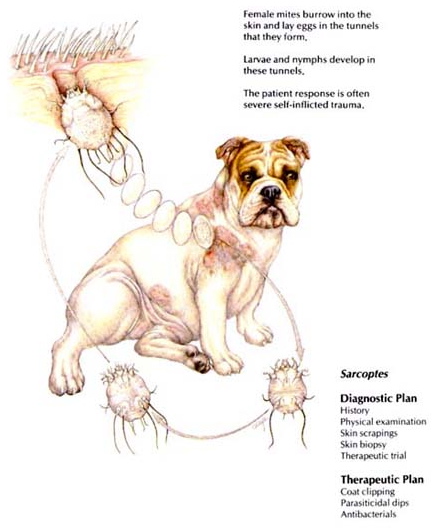Scabies (sarcoptic mange) is caused by the mite, Sarcoptes scabiei var. canis. Mites live in the superficial layers of the skin where they burrow, breed, and lay eggs. Once the adult female lays an egg, it takes 17 to 21 days for that egg to hatch and grow into an adult mite. Scabies mites do not survive for prolonged periods without a host - as such, they are generally passed by direct contact with other dogs. This contact may occur through play, boarding, grooming, or any place that the dog has had contact with other dogs. In a number of cases, however, no known contact has occurred or been known to occur.
The hallmark of this disease is intense pruritus (itching) that may only be partially responsive to steroids or other drugs. Classic scabies will manifest as red papules (bumps) to the chest, abdomen and, as time progresses, a thick scale or crusting will develop on the ears, elbows, and hocks. Fever, lymph node enlargement, and weight loss with secondary bacterial infection may occur in severe and chronic cases.

Diagnosis
To definitively diagnose this disease, the mites must be seen microscopically on skin scrapings or by fecal exam. This can be very difficult because the number of mites may be very small at any given time. Inability to find mites does NOT eliminate or rule out the possibility of this disease. If sarcoptic mange is suspected, the pet should be treated as such. Empirical treatment of these suspects, and a pet's response, may be the only way to diagnose the disease and cure the dog.
Treatment
Several medications are effective in killing sarcoptes mites. Some of the choices include injectables, topical spot-on products, oral medications, and body dips or rinses. Treatment is continued throughout the life cycle of the mite (17 to 21 days). If secondary bacterial infection is present, antibiotics may also be prescribed. Corticosteroids may be used to help control pruritus while in the process of killing the mites. There is no contraindication for the use of steroids in these cases.
Environmental Control
The treatment protocol should include cleaning the animal’s immediate environment and bedding. No specific disinfectant or product is needed. Scabies mites do not thrive off of a host, however large numbers of mites on the dog may increase the chance of mite populations in the environment. This may increase transmission to other pets or people in the household. Therefore, the area should be fumigated and treated with a “flea product” to eliminate mite numbers in the household.
Zoonosis (Contagious to people)
Sarcoptes mites much prefer the pet in the household to the human inhabitants. Some people are more susceptible than others to picking up the mite infection. In the event of zoonosis, contact your physician and notify him or her that a pet in the household has been diagnosed with Sarcoptes scabiei mite infestation.
The clinical signs often seen with human exposure are small red papules (bumps along the waist, chest, and arms) that are often very itchy. Scabies infestation in people is often self-limiting and may or may not require therapy. Treatment usually consists of a topical permethrin cream to eliminate the mites.
Contributed by: Karen Helton-Rhodes, DVM, Diplomate ACVD
Illustration reprinted with permission by the copyright owner, Hill’s Pet Nutrition, Inc.